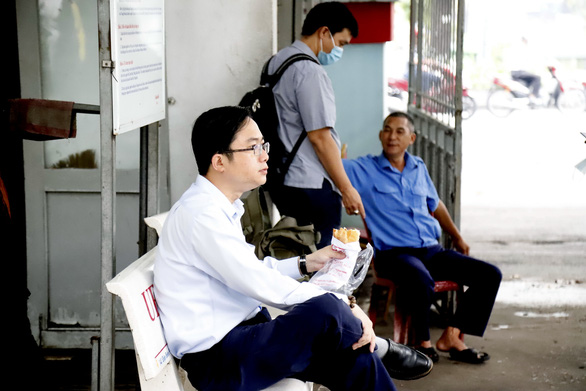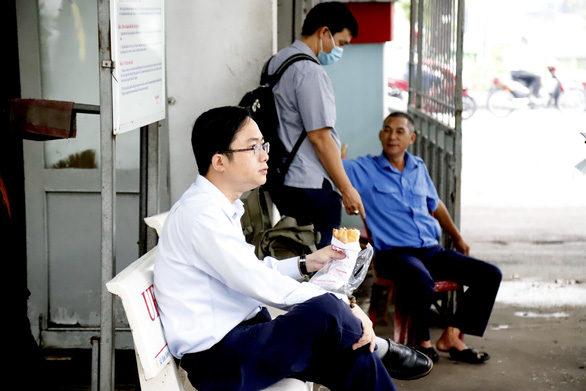A close distance between home and work can help reduce traffic congestion

In modern cities, it is necessary for the distance between home and work to be short enough to help reduce traffic volume and prevent congestion.
It is a model many cities around the world have adopted.
Many research projects also aim for this.
That is what architect Vo Kim Cuong, former deputy director of the Ho Chi Minh City Department of Planning and Architecture, told Tuoi Tre (Youth) newspaper in a recent discussion.
According to Cuong, not many cities in the world have managed to successfully follow this model.
Hard-to-reach model
In reality, urban development is market-oriented and demand-driven to meet the needs of residents, which are always diverse. It is easier to serve a single individual than the whole family.
For instance, in a couple’s family where the wife works in a hi-tech park while the husband is a doctor at a hospital in another district, it does not work for both of them to live near the hi-tech park.
In addition, people’s preferences vary when it comes to choosing a residence.
A person may like to live in a ‘tube house,’ while another person opts for an apartment or a house with a garden.
A person may choose public transportation, while another prefers a personal car.
A close distance between home and work is thus important but not all that necessary in terms of urban planning.
As a result, there is a common dilemma that some urban areas with numerous workplaces do not provide enough houses, while others with many housing projects fail to meet employment and infrastructure requirements.
Easier planned than done
This issue is attributable to the gap between planning and implementation in Ho Chi Minh City.
Currently, local authorities still apply old methods to planning without the careful consideration of resources and development trends, according to Cuong.
“If the authorities had a strong sense of synchronous urban development, [Ho Chi Minh] City’s infrastructure would be different,” Cuong said.
|
|
| Dao Van Han, a lecturer at the Vietnam National University-Ho Chi Minh City, and his wife Dang Thi Tuyet An, a planning and finance officer at the University of Economics and Law under the VNU-HCM, play with their twin children in a 35-square-meter apartment at the university’s public housing complex. Photo: Nhu Hung / Tuoi Tre |
According to the experienced architect, Ho Chi Minh City has spread its resources on too many projects in different areas without a specific focus on each of them while the metropolis should tailor the planning and management work based on those areas’ actual situations.
For example, the urban development in District 1 has reached stability and thus does not require many management resources.
It is more necessary to pay attention to areas that are quickly urbanized, with a high population density, but facing a lack of adequate planning and urban management mechanisms such as Binh Chanh and Hoc Mon Districts.
The mechanisms Cuong mentioned include investment management and infrastructure development.
“Our urban management has not met these [requirements] yet, […] so it will develop spontaneously, driven by the market,” Cuong said, citing the ‘eastern city’ to be developed in Ho Chi Minh City as an example.
“As a result, the authorities will fail to implement the urban development as originally set out.”
Making fixes
But recently, the Ho Chi Minh City Department of Planning and Architecture has worked to fix these shortcomings, Cuong said.
Among the first resolutions are planning and zoning.
Wherever urban development has been stable, the city only needs to zone it according to regulations. Places needing further development should be encouraged with policies.
“In the immediate future, local authorities need to make an urban development program by creating conditions for both individuals and businesses as soon as possible,” the former planning leader said.
“The authorities must take care of infrastructural development and choose between direct investment and public-private partnership.”
The partnership Cuong referred to is the cooperation between local authorities and landowners.
“If a place does not have proper infrastructure, it cannot be developed into an urban area,” Cuong said.
Other resolutions include mobilizing infrastructure fees from residents, or encouraging them to exchange land for shares.
In addition, authorities also need to attract foreign investment for infrastructural development.
In this fashion, the city will be able to benefit its people with housing, commercial, service, and social infrastructures.
Investment in traffic infrastructure in suburban areas
There are currently many residential projects in Thu Duc District and District 9, Ho Chi Minh City.
But their scale is small and they are not planned to form a certain city.
The two districts’ planning has basically been ruined by the uncontrolled sale of empty land lots.
As a result, local people have faced a lack of land for public infrastructure.
There should be a review to stop this situation.
In the long term, there must be large-scale and well-planned projects, with land plots for social infrastructure, in this area.
Particularly, these new projects should be developed on the outskirts, with more investment in traffic infrastructure.
Local authorities should create favorable conditions for investors and do more research to understand the needs of the locals.








